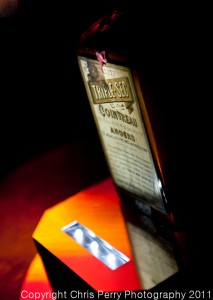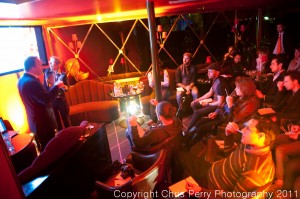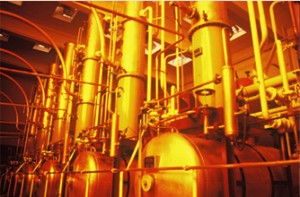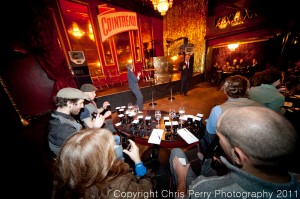The Cointreau Academie is something BarLifeUK have heard nothing but great things about…
Three days in France drinking, learning, eating and partying sounds amazing. So when Cointreau told us they were bringing a condensed version to London, we were there in a flash.
The event was held at the latest top-end cocktail pop-up bar, a trend which seems to be all the rage at the moment. This particular venue, the Cointreau Prive, is right next to Piccadilly Circus tube in London and is a very grand building with drinks being knocked out by Paul Mant and Joe Stokoe. Add to that Dita Von Teese (who helped with the design) turning up regularly, and not surprisingly it is a pretty popular haunt.
At 2pm gaggle of bartenders entered sharing stories of recent Christmas party incidents (‘…and they didn’t even drink all of the booze…’) to be greeted by the Remy Cointreau On-Trade Brand Manager Richard Lambert. Unfortunately Alfred Cointreau himself had had to head back to France for family reasons, but we were in safe hands with Richard and later Master Distiller Bernadette Langlais.
History time
Richard started us off with a bit of history, of which Cointreau has plenty, being as it is, over 160 years old. The Cointreau family based in Angers, France, originally produced a cherry liquor for which they were very well known. They then moved onto an orange curacao before eventually Triple-Sec and Cointreau the brand was born.

It was in actual fact Cointreau who invented Triple-Sec as a concept, and the original bottles were labelled simply as Triple-Sec. When other brands of Triple-Sec started popping up they tried to trademark the name, however due to the wording being so generic it was a battle they were to lose and after a brief stint as Cointreau Triple-Sec the name changed simply to Cointreau in 1920 (indeed they took Triple-Sec off the label entirely in 1950).
Seeing as they invented the stuff it seemed like the perfect opportunity to finally dispel the myth about the name Triple-Sec. Is it Triple for Triple Distilled/Triple Refined, for Three Orange types or for the fact it is Triple orangey? As it turns out it is quite simply Triple for the triple concentrated orange flavours and aromas. Sec? Well that’s French for Dry.
Random fact for you – Do you get pissed off at the constant ad breaks on TV or at sitting in the cinema waiting for your film to start only to be told to buy a VW Golf? Well you can blame Cointreau for that. The first advert ever made on film was for Cointreau.
To back up the history of Cointreau we were then shown a little film explaining that a lot of the classic cocktail books and first printing of recipes contain Cointreau. The first mention of the Sidecar comes in Robert Vermeire’s 1922 book Cocktails, How to Mix Them and Cointreau is used. The same can be said for the Margarita when first published in the 1952 book The School of Bartending. The list went on.
Distillers secrets
After the history came the lady that makes it all happen, Master Distiller Bernadette Langlais. Bernadette certainly knows her oranges and one of her jobs is to travel the world visiting every orange grove that supplies Cointreau and checking the quality is there. Every supplier, every year, every time. This is a lady that could give Messer’s Gakuru, Briars and Winchester a run for their money in a game of Air Mile Top Trumps.

Bernadette explained that Cointreau contains just 4 ingredients – Orange peel, alcohol, sugar and water. As far as the final three ingredients are concerned, purity and neutrality are key. Everything is done, including the purification of the water by reverse osmosis, to ensure that all of the flavour and aroma comes from the orange peels.
They use both Sweet and Bitter orange peels, although whilst the Sweet is used both dried and fresh, the Bitter is used only dried. These peels come from Spain, Brazil and North Africa, the dried versions being dried on location and shipped to Cointreau.
We were handed dried peels which Bernadette had bought over. Snapping them open revealed the aromas and a distinct difference between the sweet and bitter giving us an immediate insight into the different elements they bring to the final product. These dried peels go straight into the pot stills with the base spirit and are left overnight to macerate before distillation begins.
The fresh peels on the other hand are macerated for several months from the moment they arrive at the distillery and it is the fresh peel that gives Cointreau its candied fruit notes.
Still important
The stills themselves are housed in the Alembic Room and are a mixture of pot and column, it is in the column still that a lot of the magic happens. The column still houses a series of trays in which holes are drilled, these holes allow the vapours to rise as well as allowing some of the alcolate (distillate) liquid to drip back down. It is the meeting of the vapours and the alcolate that is one of the secrets in Cointreau’s flavour and aroma.

The number of trays and holes in said trays within each column still makes a huge difference in the effect this process has. It was at this point we discovered for the first time that as lovely as Bernadette seems, she guards her secrets very well. This question and a series of others fired at her by the room were met with a big smile and a very polite ‘it’s a secret’.
To placate us Bernadette had brought along the Head, Heart and Tail of a recent run at the distillery. It was used as a demonstration in the importance of the point of cutting used by Cointreau.
The Head was a not unpleasant aroma although the sweetness was over stated giving it an almost sickly sweet quality, the Heart as you would imagine smelt very much like Cointreau however the Tail was a smell so bad, almost mouldy, that it reminded me of an Aftershave Andy used to own. Seeing Sarah Mitchell in front of me almost dry heave when she smelt it really reminded me of it.
Once the cut has been made the alcolate is taken from the still at around 88% ABV and then mixed with water to bring it down to 50% ABV. When the water is added the liquid becomes cloudy due to the essential oils. For this reason it is then put into another centrifuge to clear it up, creating what they call a ‘refined alcolate’ (in the days before technology they had to wait for natural separation). The final stage in the process is the adding of the sugar, Cointreau uses 240g per litre which in the world of liqueurs and Triple-Sec’s is a low percentage. To ensure it isn’t an over sweet product (remember ‘Sec’ means Dry)

We were then invited to a blind tasting of 4 different orange liqueurs designed to show the difference in taste of the variety that’s out there. Unsurprisingly with a room full of educated palates such as was in attendance the different brands were quickly spotted, however everyone agreed the difference was more noticeable between the brands than they had previously thought. The favourite on the day was, of course, Cointreau.
We were finally treated to some classic Cointreau cocktails made by Joe Stokoe and conversation quickly turned to when the next trip to France was and more importantly how we could get on the list. I suggested a round of arm-wrestling to thin down the field but everyone was too busy drinking to give me much attention.

